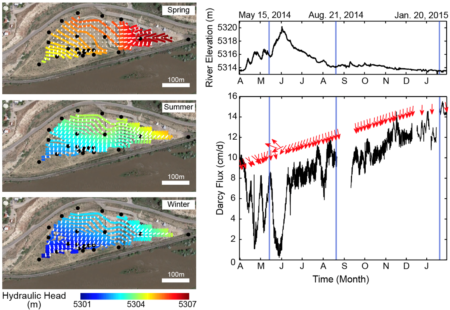
(Left) Map of hydraulic head in the floodplain aquifer across three sampling seasons. Samples for this study were collected in the river in the bottom left of the image. The black dots indicate groundwater monitoring well locations used for hydrologic calculations. (Upper right) River stage hydrograph for the Colorado River with sampling times indicated by blue lines. (Lower right) Magnitude (black line) and direction (red arrows) of Darcy flux through the floodplain aquifer near the sampling location based upon local hydraulic head calculations. Groundwater flow is generally south toward the river.
Scientific Achievement
Seasonal variations in snowmelt-driven river stage on the Colorado River drives strong redox fluctuations across a ~80-cm vertical portion of the riverbed, and results in the assembly of a unique ‘hyporheic’ microbiome
Significance and Impact
Biogeochemical fluctuations in the hyporheic zone are impacted by changes in snowmelt. An understanding of these dynamics is critical for predicting fluxes of metals, carbon, and other nutrients from this reactive hotspot
Research Details
- Strong changes in snowmelt-driven river stage altered patterns of hyporheic mixing in the Colorado River, adjacent to the Rifle site.
- This mixing modulated redox fronts in the riverbed, with greater dissolved iron concentrations at shallower depths during periods of low river discharge
- Dynamic mixing and geochemical conditions in a ~80-cm vertical section of the riverbed resulted in a microbial community that was distinct from those in river water and groundwater
Citation
Danczak RE, AH Sawyer, KH Williams, JC Stegen, C Hobson, and MJ Wilkins. 2016. Seasonal hyporheic dynamics control coupled microbiology and geochemistry in Colorado River sediments. Journal of Geophysical Research – Biogeosciences. 121: 2976-2987, DOI: 10.1002/2016JG003527
